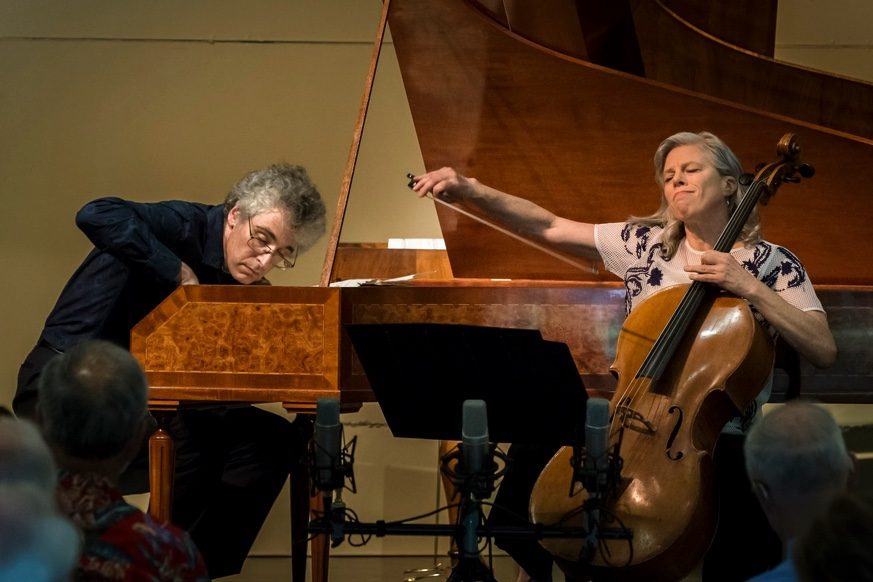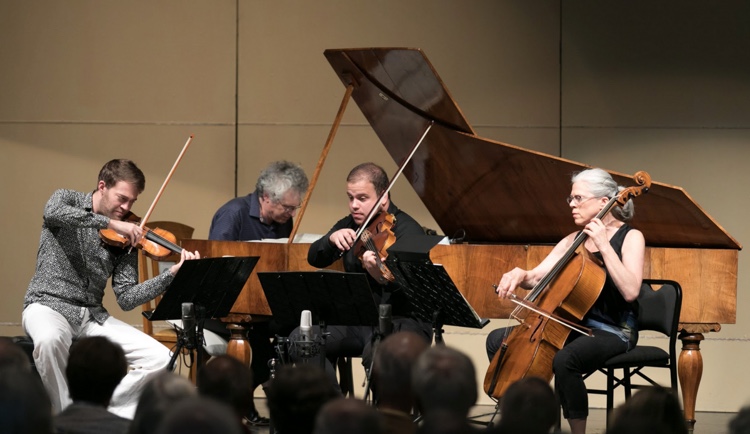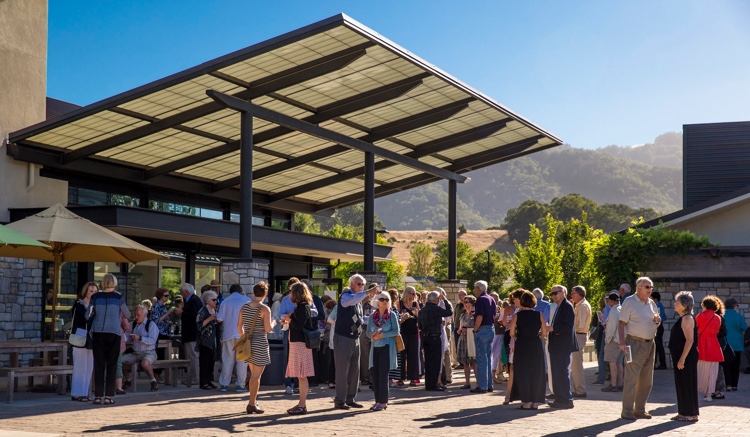
By Philippa Kiraly
In 2013, retired California entrepreneur Martin Cohn received a request for advice from an old friend, cellist Tanya Tomkins, and her partner, fortepianist Eric Zivian. Cohn had a place in Sonoma in California’s wine country and asked them to lunch.
“I had no idea what they were thinking about,” Cohn said.
Turned out, it was a music festival they were mulling over, a festival of Classical and Romantic music performed on period instruments. After considering places all over the state, Cohn said, ”Why not here?,” and the concept of the Valley of the Moon Music Festival was born. Cohn is president of the board and Tomkins and Zivian co-founders as artistic director and music director, respectively.
Of course, it wasn’t that easy, and a lot of hard work and fund raising had to take place. But a newly built small auditorium with good acoustics — the Hanna Boys Center Fine Arts Auditorium — was available. Local people stepped up as hosts for musicians and offered space for informal concerts on their winery patios and cases of wine for post-performance receptions, as well as some funding. The city of Sonoma also pitched in.

Tomkins and Zivian had years of performing under their belts — for Tomkins both on early and modern cello, while Zivian around 2000 took up the fortepiano, an instrument in which he long had an interest. “I was always a bit frustrated with modern piano,” he said. “A fortepiano is much more satisfying for me.”
Tomkins had a wide range of colleagues playing period instruments on whom to draw for performances.
“At a certain point in one’s career, you want to put your own personal stamp on what you offer,” said Tomkins, noting that the festival originally was Zivian’s idea. “Starting the festival has given us such a different view of how things work. We’ve learned so much and expanded so much, both as people and as musicians. The big thing about it is it’s so gratifying. There are so many festivals which focus on Baroque music and none focusing on the Classical and Romantic, which is what we do.
“I love Schubert, Brahms, Beethoven,” she continued. “I can’t imagine not playing Ravel. It really works for me when the music becomes a storytelling vehicle, and old instruments can capture this better than modern ones. The biggest difference when using uncovered gut strings is what is lost in volume is more than made up in variety of colors and sound palette.”
The Valley of the Moon Music Festival (VMMF) began in 2014. With only minor format tweaks since the start, it offers six programs over three weekends (this year, July 14-28), plus an apprentice program that has been in place from the beginning and includes an annual lecture series.

Last year, the festival programmed an early Schoenberg work; this year, Stravinsky has his turn.
Tomkins owns several English cellos, made from the late-18th to the late-19th centuries. Zivian has fortepianos by Dulcken and Rausch — “Chopin sounds beautiful on this” — and expects to rent a Chickering from 1899 for this year’s concerts.
“It took me years to get really adjusted to the touch, but it has become much easier to get the sound I wanted that I could not get from a modern piano,” said Zivian. “Whenever I play a piece on the fortepiano that I haven’t before, it’s a revelation, closer to what they would have heard when it was built. That’s why they played that chord! The whole bass register is less wooden, the stringing separates out the notes. It’s more exciting, more articulated, more present.”
Dividing the chores between them, Tomkins is responsible for the overarching theme of each festival and Zivian is the detail person. “He’s wonderful at taking the idea and creating these wonderfully specific detailed programs out of it,” Tomkins said.
Both Tomkins and Zivian are in their 50s, and both feel driven (their word) to do this. “The world around us is so chaotic, it feels so nice to be able to bring the joy of music and intriguing stories to people. Being able to live in this way feels very meaningful,” said Tomkins.
It can be all-consuming. “Eric and I wake up doing the festival and fall into bed doing the festival,” she said, confessing that at about the third year, they almost gave up — for about an hour. And then, one of them was saying, “About the first program…”
“It’s very, very exciting for us,” said Zivian, “and exhausting, since we both play at the festival and at other festivals. We are going to try more winter concerts as well.”
One thing they have not had to do is sell the festival idea to the community. Sonoma is small, people know each other, and from the start Tomkins and Zivian have had community support. “Until this began, there was no classical music in Sonoma,” said Cohn. “If Tanya and Eric ever had a doubt, they never said. Tanya is very good with people. Everyone loves Eric. There’s a certain degree of civic pride and music lovers here. But it takes a while.”
“We were hooked from the beginning,” said Kimberly Hughes, owner of Bar None’s Canyon winery. ”The intimate settings are wonderful,” she said of the casual afternoon performances on winery patios. “They bring in people who otherwise wouldn’t come, and it adds to the support. I’ve been impressed with the concert attendance. It seems to increase every year. We go to several, and they are always packed. It’s wonderful to see so many people.”
This summer’s theme is “Salonnières: Women of Power and Influence” and includes chamber music from Bach to Stravinsky. Tomkins began to look at 19th-century salons run by women of wealth — often titled, musical patrons who had little by way of outlets for their own musicianship. The more she studied them, the more fascinated she became. A festival devoted to their salons became a way to highlight them as entrepreneurs and presenters, Tomkins said.
“They’re having these intimate festivals in their houses, what we are doing now, but they were more than that. This is how the women circumvented the constraints of their lives. I don’t think Fauré would be on the map at all without Winnaretta Singer. I am so excited by these salonnières. The more I read about them the more impressed I am.”
Frequently their salons included songs, and the festival line up reflects that. This year’s concerts focus on six remarkable women and composers they presented: Winnaretta Singer, Princesse de Polignac (Fauré, Wagner, Hahn, Chausson, Stravinsky) held salons of mixed genders, guests who were there because of the music; those of Sara Levy (C.P.E. and W.F. Bach, Mozart, Mendelssohn) and Fanny Mendelssohn Hensel (Felix and Fanny) brought Jews and gentiles together; plus Princess Cristina Belgiojoso (Chopin, Franck, Liszt, Robert and Clara Schumann, Bellini, Rossini), Countess Maria von Thun (Mozart, Haydn, Clementi, Beethoven), and Clara Schumann (Joachim, Robert and Clara) all furthered the lives and careers of the composers they invited to play at the salons and to whom they gave patronage and exposure.
Inaugurated last season, the lecture series is funded by the Blattners — Kimberly (on the board) and Simon (on the Advisory Board). “They’re very generous in support,” said Zivian. The series follows the festival theme this year, discussing the social and musical context of the 19th-century salon.
From the start, Zivian and Tomkins have been mentors to young performers on period instruments. They consider their full-scholarship apprenticeship program a core ingredient of the festival. It comprises two weeks of intensive coaching by festival faculty with an emphasis on performance and each year brings back several previous apprentices in laureate positions to join their erstwhile mentors in performance. This year, there are five apprentices: two violinists, one violist, one cellist, and a fortepianist.

They are hosted in the valley by people such as Hughes of Bar None’s Canyon, who donates money to help cover expenses and a case of wine.
“We’ve sponsored a student each year, just helping them to be able to perform,” said Hughes. “I say student, but they sound very professional. And donating wine makes nice a partnership for the festival with the different wineries. It’s a pleasant way to end a concert and promote the winery.”
“People love to host,” said Cohn, who also hosts musicians, “particularly the apprenticeship program — seeing the kids, our hope for the future. I find our audience members and hosts get very invested in the lives of their musicians. It’s very personal. They follow them on Facebook.”
Most concerts today are selling out. “It feels as though it could be in a hall in Vienna,” said Hughes. “It’s so beautifully professional, a most elegant experience. The music feels so important and is so well done. But no one is formally dressed. This is Sonoma!”
Philippa Kiraly has been a freelance classical music critic since 1980. She has written for the Akron Beacon Journal, the Seattle Post-Intelligencer, City Arts, and The Sun Break, and now contributes to BachTrack and Sybaritic Singer.

